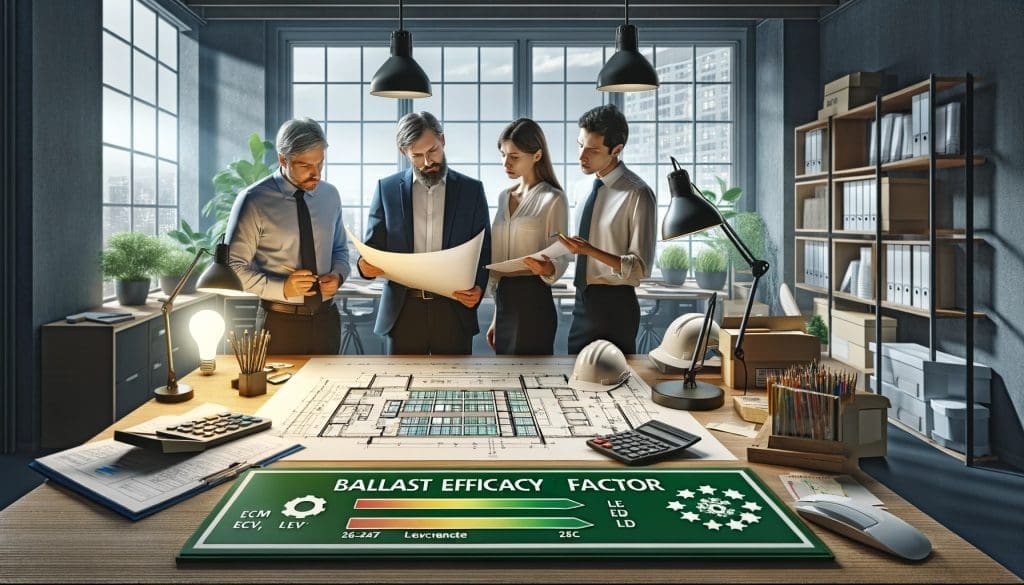Can Poor Ballast Efficacy Violate Energy Codes?
In the realm of energy efficiency and environmental sustainability, the concept of the Ballast Efficacy Factor (BEF) stands out as a pivotal metric. This term, crucial in the context of fluorescent lighting technology, has increasingly become a focal point in discussions surrounding energy conservation and legal compliance within the industry.
BEF is fundamentally a measure of the efficiency of a fluorescent lamp’s ballast. It is calculated as the ratio of the luminous efficacy of a lamp to the total power input of the ballast. In simpler terms, it gauges how well a ballast converts electrical power into visible light, an important consideration in energy conservation. This metric is not just a technicality but a significant factor in energy standards and regulations.
The relevance of BEF in the legal sphere primarily revolves around energy regulations and standards that govern the efficiency of lighting fixtures. In the United States, for instance, the Energy Policy and Conservation Act along with various state-level statutes have provisions that directly or indirectly address the efficiency of lighting components, including ballasts. The compliance with these regulations is not just a matter of legal obligation but also an aspect of corporate responsibility towards energy conservation.
From a legal perspective, understanding and complying with the requirements related to BEF is crucial for manufacturers and suppliers of lighting fixtures. Non-compliance can lead to legal challenges, including fines and other penalties. More importantly, it can affect a company’s reputation in an increasingly environmentally conscious market.
Moreover, the significance of BEF extends beyond just legal compliance. It is a key factor in sustainable building design and green certification processes like LEED (Leadership in Energy and Environmental Design). Efficient lighting is a cornerstone of sustainable architecture, and BEF plays a vital role in determining the suitability of lighting fixtures for such applications.
The impact of BEF is also felt in the energy efficiency retrofitting industry. As older buildings are upgraded to meet modern energy standards, the choice of ballasts with a high BEF rating becomes a critical decision. This not only ensures compliance with energy regulations but also results in significant cost savings over time due to reduced energy consumption.
For consumers, understanding the concept of BEF is essential when making decisions about lighting. Choosing products with a high BEF rating translates to lower electricity bills and a smaller carbon footprint, aligning with the broader goals of energy conservation and environmental sustainability.
The legal implications of BEF also extend to the international arena. With the global push towards reducing energy consumption and minimizing environmental impact, countries around the world are adopting standards similar to those in the U.S. This creates a complex legal landscape for international manufacturers and exporters of lighting products, who must navigate varying regulations across different markets.
In conclusion, the Ballast Efficacy Factor represents a critical intersection between technology, legal compliance, environmental sustainability, and economic efficiency. It exemplifies how a seemingly technical metric can have far-reaching implications in the legal and environmental landscape. As the world continues to focus on reducing energy consumption and minimizing environmental impact, BEF will undoubtedly remain a key factor in shaping the future of lighting technology and energy standards.
In summary, the Ballast Efficacy Factor is not just a measure of efficiency; it’s a testament to the evolving relationship between technology, law, and environmental stewardship. It serves as a reminder that even the most technical aspects of our industries can have profound legal and environmental implications.
- Baker v. Selden Supreme Court Decision – Justia
- Baker v. Selden Case Analysis – Cornell Law School
- The Story of Baker v. Selden – UC Berkeley Legal Scholar
- Idea-Expression Dichotomy Legal Analysis – Lakshmisri Law Firm
- Baker v. Selden Primary Sources Commentary – Copyright History













